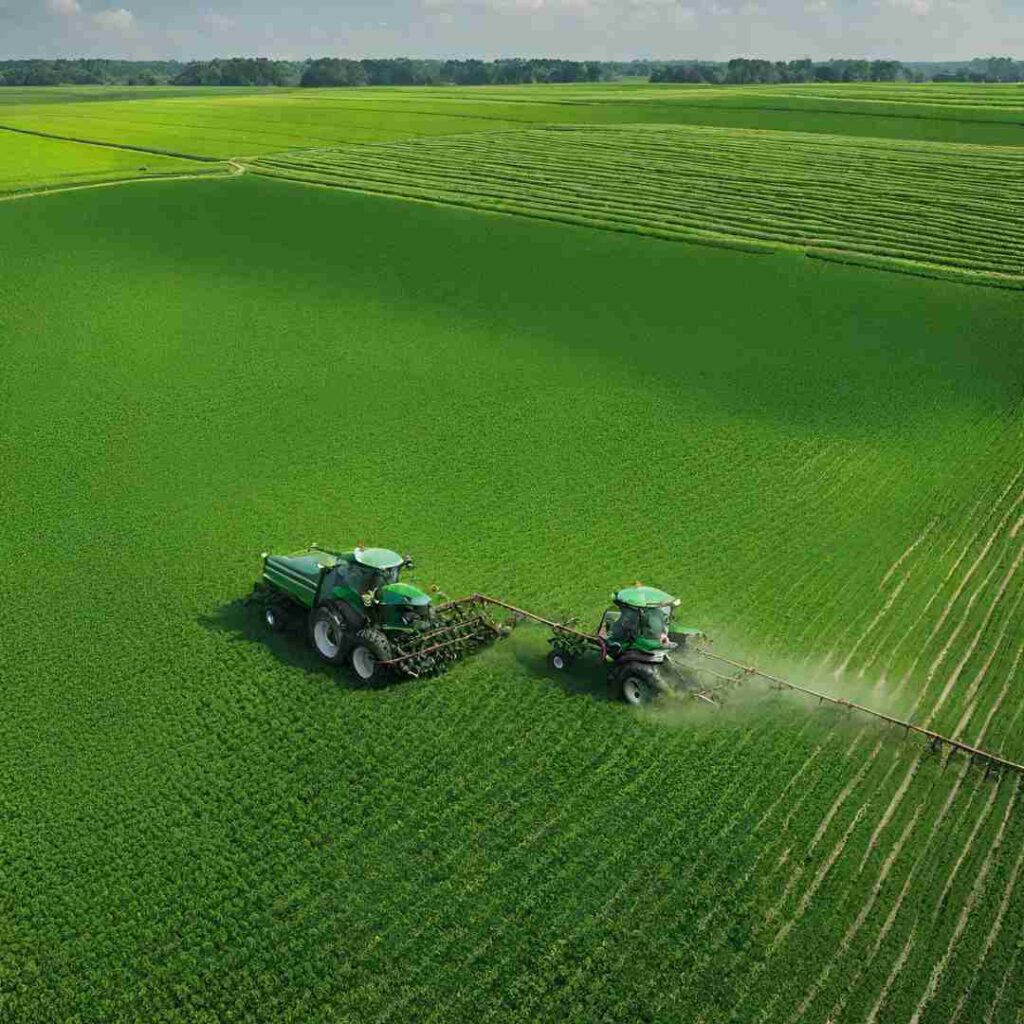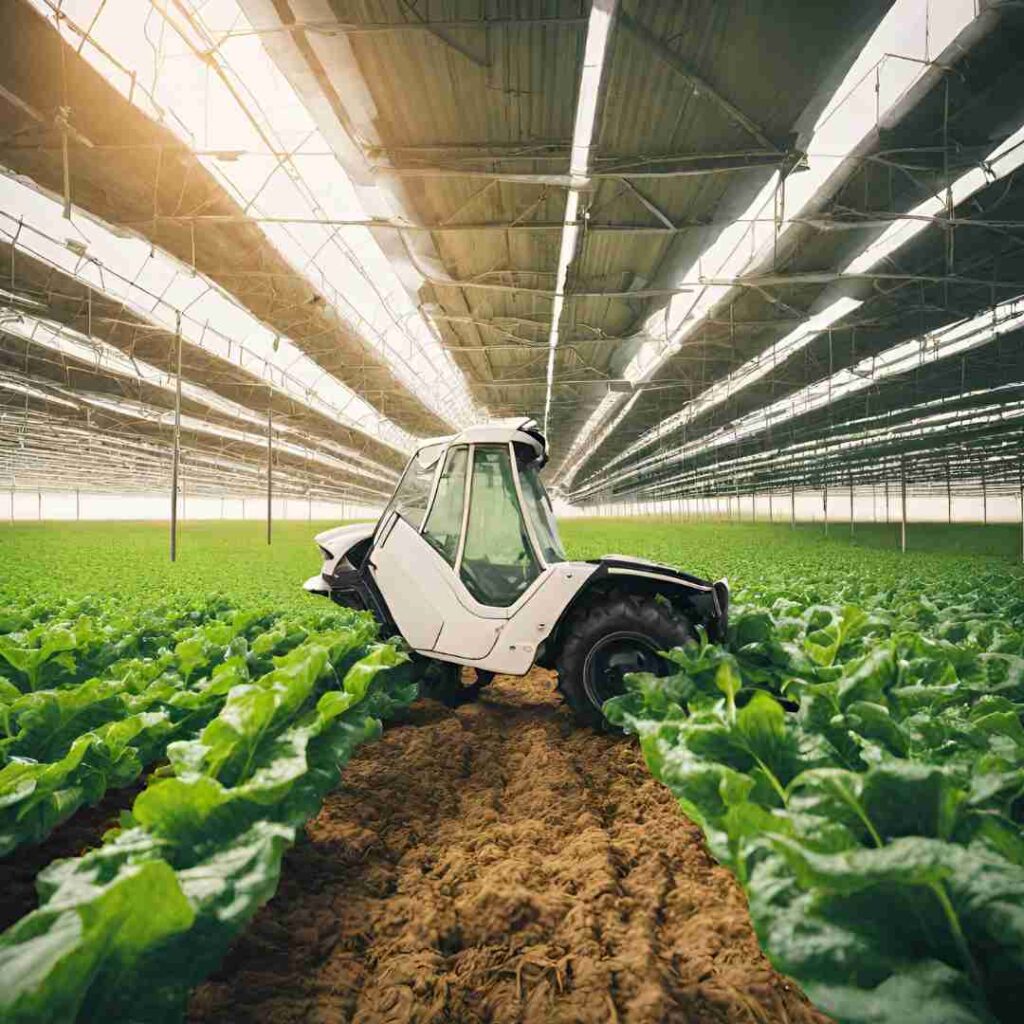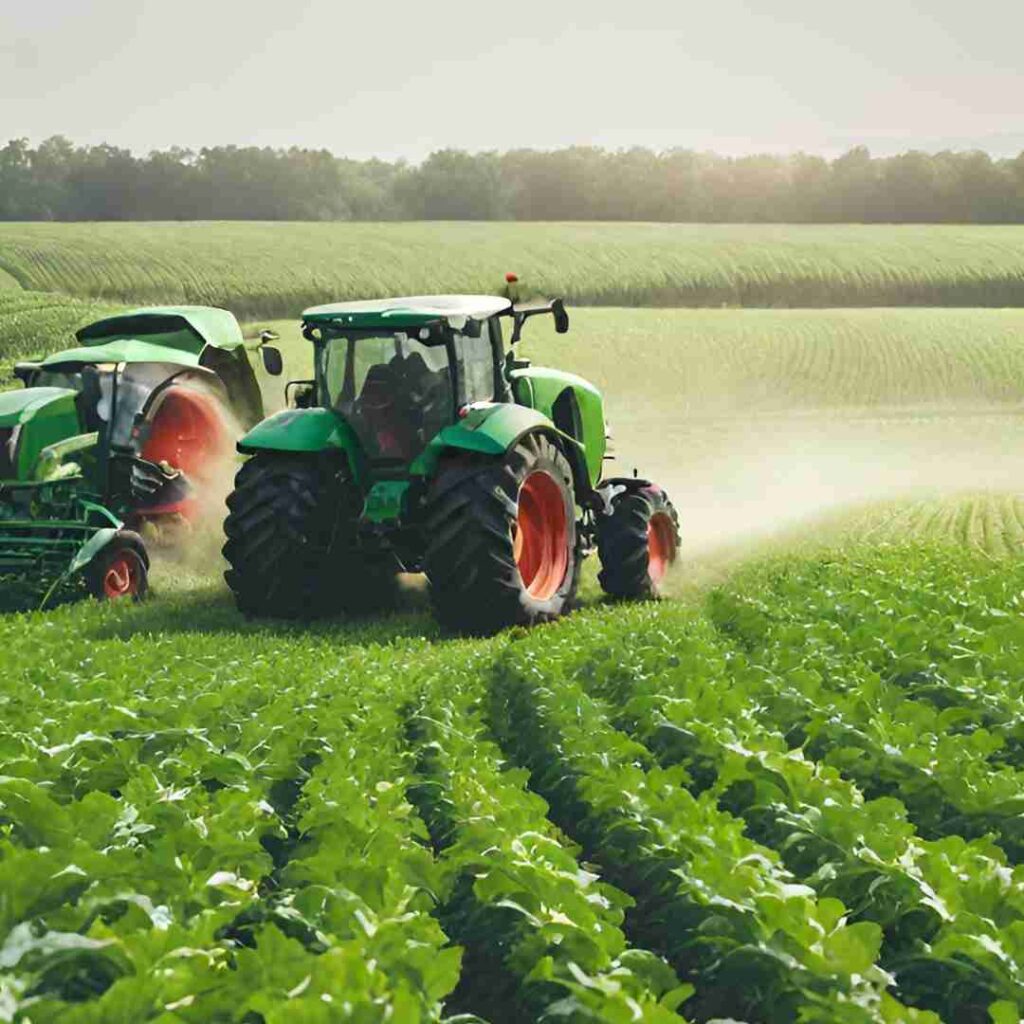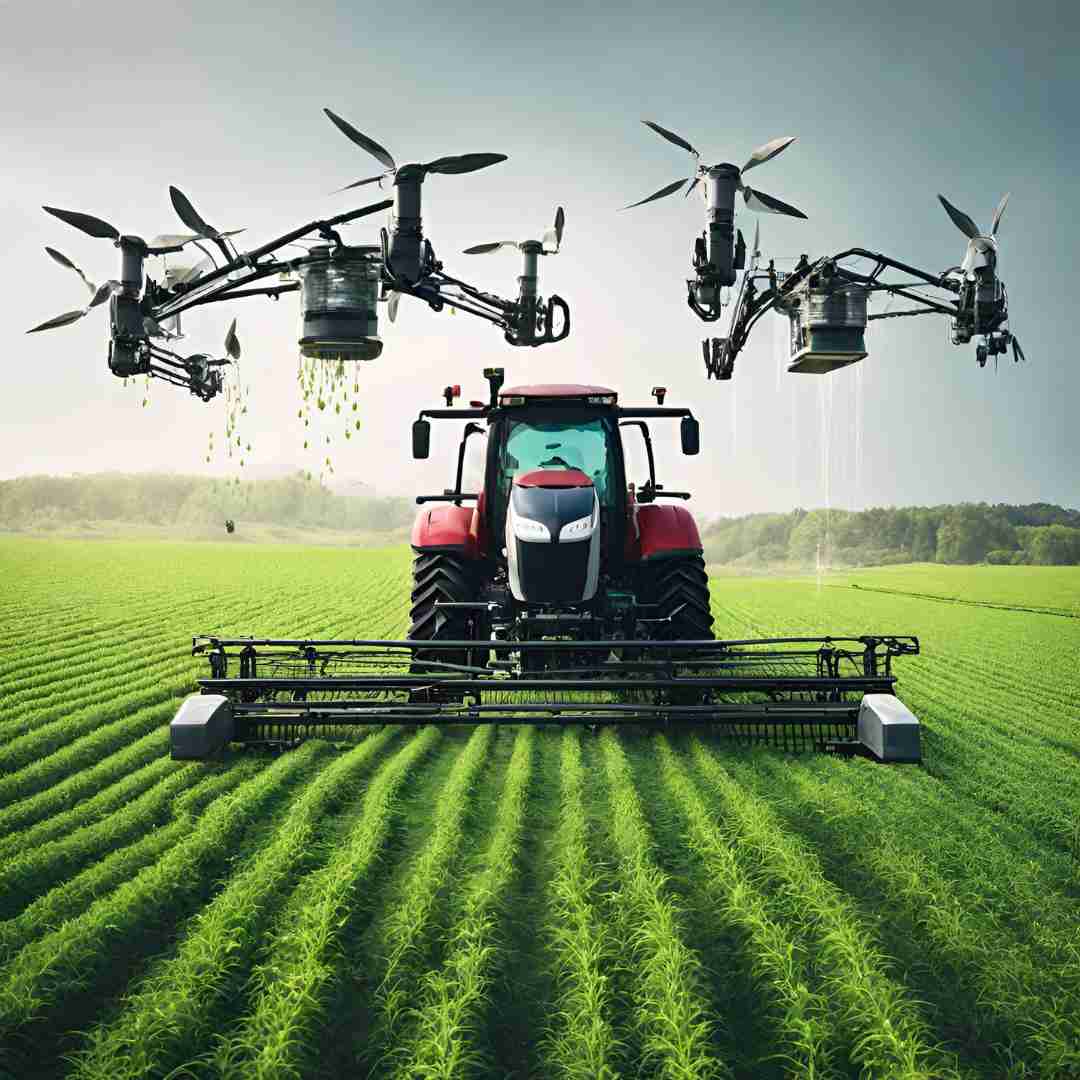Table of Contents
I. Introduction
How can AI Help in Agriculture? In an era where technological advancements are reshaping industries, agriculture stands at the forefront of transformation. The integration of Artificial Intelligence (AI) in agriculture has opened up new horizons for farmers, offering innovative solutions to age-old challenges. From precision farming to livestock management, AI is revolutionizing the way we cultivate and harvest our crops. In this comprehensive guide, we will delve deep into the multifaceted world of AI in agriculture.
Why AI in Agriculture Matters
Agriculture is not just about planting seeds and reaping the harvest anymore. It’s about optimising every aspect of the farming process, from soil health to weather forecasts, and from pest control to resource allocation. AI is the driving force behind this transformation. It empowers farmers to make data-driven decisions, conserve resources, increase yields, and ultimately, ensure food security for a growing global population.
The Promise of AI
Artificial Intelligence, often referred to as AI, encompasses a range of technologies that enable machines to mimic human-like intelligence. This includes the ability to learn from data, make predictions, and adapt to changing circumstances. In agriculture, AI manifests in various forms, from smart sensors and drones to complex data analytics platforms.
II. Understanding AI in Agriculture
Before we dive into the specific applications of AI in agriculture, it’s essential to grasp the fundamentals of how AI functions within this sector.
AI in Agriculture – The Basics
AI in agriculture involves the deployment of cutting-edge technologies to automate and enhance farming processes. At its core, AI relies on the collection of vast amounts of data from various sources, including soil sensors, satellite imagery, and weather stations. This data is then processed and analysed to make informed decisions.
Machine Learning and Data Analysis
One of the key components of AI is machine learning. Machine learning algorithms can identify patterns and trends within the collected data, enabling the system to make predictions and recommendations. For example, a machine learning model can analyse historical weather data to predict optimal planting times or assess crop health based on images of the field.
IoT and Connectivity
The Internet of Things (IoT) plays a pivotal role in AI-driven agriculture. IoT devices such as soil moisture sensors, drones, and smart tractors collect real-time data and transmit it to centralized systems for analysis. This connectivity enables farmers to monitor and manage their operations remotely, increasing efficiency and reducing labor costs.
The Role of Big Data
The agricultural industry generates vast amounts of data daily, from soil quality measurements to crop yield records. AI harnesses the power of big data to provide actionable insights. By processing and analysing this data, AI can optimize resource allocation, reduce waste, and enhance overall farm productivity.
Benefits of AI in Agriculture
The integration of AI in agriculture offers a plethora of benefits, including:
- Increased Efficiency: AI-driven systems can perform tasks more quickly and accurately than humans, leading to higher productivity.
- Resource Conservation: AI helps farmers make data-driven decisions regarding water and fertilizer usage, reducing waste and environmental impact.
- Enhanced Crop Quality: By monitoring crop health and identifying issues early, AI can contribute to higher-quality produce.
- Cost Reduction: Automation and predictive maintenance can lower operational costs, improving the financial viability of farming.
- Sustainability: AI promotes sustainable farming practices by optimizing resource usage and reducing the reliance on harmful chemicals.
As we delve deeper into this article, we will explore these benefits in greater detail, looking at real-world examples and case studies to illustrate the transformative power of AI in agriculture. Next, we’ll explore the first application of AI in agriculture: Precision Farming.
III. Applications of AI in Agriculture

A. Precision Farming
Precision farming, also known as precision agriculture, is a prime example of how AI is reshaping the way we approach agriculture. It involves the use of technology to optimize various aspects of crop cultivation with incredible precision. Here’s an in-depth look at how AI is revolutionizing precision farming:
1. Soil Analysis and Management
AI-powered sensors are placed throughout the fields to collect data on soil quality, moisture levels, and nutrient content. This data is then analysed to determine the best planting strategies, irrigation schedules, and nutrient application rates. Precision farming ensures that crops receive exactly what they need, reducing wastage and increasing yields.
Case Study: The Western Growers Center for Innovation & Technology
This center in California utilizes AI-driven soil sensors to optimize irrigation, leading to significant water savings and increased crop yields.
2. Weather Predictions and Crop Monitoring
AI algorithms process weather data to provide accurate forecasts, helping farmers prepare for extreme weather events. Additionally, drones equipped with AI-powered cameras can monitor crops for signs of stress, disease, or pest infestations. This early detection allows for timely interventions, minimising crop damage.
Real-Life Example: Blue River Technology’s See & Spray
Blue River Technology, a subsidiary of John Deere, has developed an AI-powered system that uses computer vision to identify and precisely target individual weeds. This reduces the need for herbicides and minimises environmental impact.
3. Automated Machinery and Robotics
The use of AI-driven machinery and robotics is transforming the labor-intensive aspects of farming. Autonomous tractors, harvesters, and drones can perform tasks such as planting, harvesting, and spraying with unmatched precision. This not only reduces labor costs but also ensures uniformity in farming practices.
Success Story: Small Robot Company
Small Robot Company, a UK-based startup, has developed AI-driven robots capable of planting, monitoring, and harvesting crops. Their robots, Tom, Dick, and Harry, work collaboratively to optimize crop management.
Precision farming is just the beginning of AI’s impact on agriculture. In the next section, we’ll explore how AI is transforming crop management, another critical aspect of modern farming.
B. Crop Management with AI
Crop management is an essential facet of agriculture that heavily relies on the careful planning and execution of various tasks throughout the crop’s lifecycle. AI brings innovation to crop management in several ways, streamlining processes and ensuring better yields.
1. Crop Planting and Harvesting
AI-driven machinery and robotics have significantly transformed the way crops are planted and harvested. Here are some key aspects:
a. Planting Precision
AI-equipped planting machines can precisely space and plant seeds according to optimal growth conditions. This ensures that each plant has the space and resources it needs to thrive.
b. Harvesting Efficiency
Harvesting robots equipped with computer vision can detect when crops are ripe and ready for harvest. They can work around the clock, ensuring that no crops are missed and reducing losses due to over-ripening.
Case Study: The Strawberry-Picking Robot
Agricultural tech companies like Octinion have developed AI-powered robots that can pick strawberries with remarkable delicacy and speed, revolutionizing the berry farming industry.
2. Crop Health Monitoring
AI plays a pivotal role in monitoring the health of crops throughout their growth cycle. This proactive approach helps identify issues early and take corrective actions.
a. Disease Detection
AI-powered image recognition systems can analyze images of crops to identify signs of disease, stress, or nutrient deficiencies. This allows farmers to intervene promptly and prevent the spread of diseases.
b. Pest Control
AI can help identify pest infestations early by analyzing data from sensors placed in the fields. Integrated pest management strategies can then be deployed to reduce the use of harmful chemicals.
Real-Life Example: The Plantix App
Plantix is a mobile app that uses AI to identify plant diseases and nutrient deficiencies from images uploaded by farmers. It provides recommendations for treatment and prevention.
3. Resource Optimization
AI aids in the efficient allocation of resources, such as water and fertilizers, based on real-time data and crop needs. This not only conserves resources but also reduces the environmental impact of farming.
a. Water Management
AI systems analyze soil moisture levels and weather data to determine precise irrigation schedules. This prevents overwatering or underwatering and conserves water resources.
b. Fertilizer Application
AI-driven equipment can apply fertilizers precisely where they are needed, avoiding excess use and minimizing runoff into waterways.
c. Crop Rotation Planning
AI algorithms can suggest optimal crop rotation plans to improve soil health and prevent the buildup of pests and diseases.
Crop management is integral to achieving high yields and maintaining the health of agricultural ecosystems. AI’s ability to optimize these processes contributes to sustainable and profitable farming.
In the next section, we’ll explore how AI aids in pest and disease detection, which is crucial for crop protection and yield preservation.
C. Pest and Disease Detection with AI

Detecting and managing pests and diseases is a constant challenge in agriculture. AI-driven solutions offer a proactive and precise approach to safeguarding crops.
1. Early Detection
AI-powered cameras and sensors continuously monitor fields for signs of pests or diseases. These systems can detect subtle changes in plant health that may not be visible to the human eye. Early detection allows for prompt action.
a. Image Recognition
AI algorithms analyze images of plants to identify patterns associated with diseases or pest damage. This technology can scan vast fields quickly, detecting issues before they become widespread.
b. Sensor Networks
IoT sensor networks placed in fields collect data on temperature, humidity, and pest activity. AI processes this data to predict potential outbreaks and trigger interventions.
Real-Life Example: Spornado’s Spore Traps
Spornado, a Canadian company, produces spore traps equipped with AI. These traps capture and analyze fungal spores in the air, providing early warning of diseases like powdery mildew in vineyards.
2. Precision Interventions
Once a pest or disease is detected, AI can recommend precise interventions, reducing the need for broad-spectrum chemical treatments.
a. Targeted Spraying
AI-guided spraying systems can target affected areas with precision, minimizing chemical usage and reducing the impact on non-target organisms.
b. Biological Controls
AI can suggest the use of biological control agents, such as beneficial insects or nematodes, to combat pests while minimizing harm to the environment.
Pest and disease detection is an excellent example of how AI can improve crop protection while minimizing the ecological footprint of agriculture. In the next section, we’ll explore AI’s role in optimizing irrigation, a critical aspect of resource management in farming.
D. Irrigation Optimization with AI
Efficient water management is crucial in agriculture, and AI is playing a pivotal role in optimizing irrigation practices. Here’s how AI contributes to irrigation efficiency:
1. Soil Moisture Sensing
AI-equipped soil moisture sensors continuously monitor the moisture levels at different depths in the soil. This data is used to determine when and how much to irrigate.
a. Precision Irrigation
AI algorithms analyze soil data and weather forecasts to create irrigation schedules tailored to the specific needs of each crop. This prevents over-irrigation, reduces water waste, and saves energy.
b. Drip Irrigation Control
In drip irrigation systems, AI can precisely regulate the flow of water to individual plants based on their requirements. This level of control minimizes water usage and ensures optimal hydration.
c. Data-Driven Decisions
Farmers receive real-time data and recommendations through AI-powered apps, allowing them to make informed decisions about irrigation, even from remote locations.
Case Study: The Netafim Smart Irrigation System
Netafim, a global leader in drip irrigation, offers AI-driven smart irrigation systems that enable farmers to maximize water efficiency while improving crop yields.
Efficient irrigation not only conserves a precious resource but also reduces energy costs and contributes to sustainable farming practices.
IV. Livestock Farming with AI
Livestock farming is a critical component of agriculture that provides us with meat, dairy, and other animal-based products. AI technologies are being integrated into livestock management to enhance animal welfare, increase production efficiency, and improve overall farm operations.
1. Health Monitoring
a. Wearable Devices
AI-powered wearable devices, such as smart collars or ear tags, are used to monitor the health and behavior of livestock. These devices can detect early signs of illness or distress, enabling timely intervention.
b. Predictive Health Models
AI analyzes data from wearable devices, such as heart rate, temperature, and activity levels, to predict health issues. Farmers can receive alerts and recommendations based on these predictive models.
Case Study: Moocall
Moocall is an AI-powered calving sensor that predicts when a cow is likely to give birth by monitoring tail movement and sends alerts to farmers, ensuring timely assistance during calving.
2. Feeding Optimization
a. Automated Feeding Systems
AI-driven feeding systems can dispense the right amount of feed at the right time, ensuring that animals receive the nutrition they need while minimizing waste.
b. Nutritional Analysis
AI can analyze the nutritional content of feed and adjust diet plans to optimize animal growth and health. This precision reduces feed costs and improves animal well-being.
c. Data-Driven Decisions
Farmers can access real-time data on their livestock’s feeding habits and adjust feed plans accordingly, ensuring efficient and healthy growth.
Success Story: Cainthus
Cainthus, a company specializing in precision livestock monitoring, uses AI and computer vision to monitor cattle behavior and assess their health and well-being. This technology improves cattle welfare and farm productivity.
3. Reproduction Management
a. Estrus Detection
AI systems can detect signs of estrus (heat) in female animals, helping farmers time artificial insemination or natural breeding for optimal reproductive success.
b. Genetic Selection
AI analyzes genetic data to recommend the most suitable breeding pairs, optimizing the genetic traits of the herd for desirable characteristics.
c. Pregnancy Monitoring
AI-powered ultrasound and imaging systems can monitor pregnancy in livestock, ensuring the well-being of pregnant animals and helping farmers plan for births.
Real-Life Example: Nedap’s Heat Detection and Health Monitoring
Nedap’s AI-based systems help dairy farmers monitor the heat cycles and health of their cows, leading to improved reproductive success and overall herd health.
By incorporating AI into livestock farming, farmers can improve animal welfare, increase production efficiency, and make data-driven decisions that benefit both their animals and their bottom line.
V. Market Forecast and Investment with AI
AI in agriculture represents a rapidly growing sector with significant market potential. Understanding the market trends and investment opportunities is crucial for both farmers and investors looking to capitalize on this technological shift.
1. Market Growth
a. Global Expansion
The adoption of AI in agriculture is not limited to a specific region. It’s a global phenomenon, with countries across the world embracing AI-driven farming solutions.
b. Revenue Projections
Market research indicates that the AI in agriculture market is poised for substantial growth, driven by the need for increased food production and sustainable farming practices.
c. Investment Inflows
Venture capital and corporate investments are pouring into agtech startups that focus on AI-driven solutions. This influx of capital is driving innovation and development in the sector.
2. Investment Opportunities
a. Agtech Startups
Investing in emerging agtech startups that specialize in AI-based agriculture solutions can offer significant returns. These startups are at the forefront of innovation and disruption.
b. Established Agribusinesses
Traditional agricultural companies are also investing in AI to modernize their operations. Investing in established players with AI initiatives can provide stability and growth potential.
c. Precision Agriculture Equipment
Companies that manufacture precision agriculture equipment, such as AI-driven tractors and drones, present investment opportunities as the demand for these technologies continues to rise.
d. Data Analytics Providers
Investing in companies that provide data analytics platforms tailored to agriculture can be a strategic choice, as data-driven decision-making becomes increasingly critical.
It’s essential to conduct thorough research and due diligence before making investment decisions in the AI in agriculture sector. The potential for growth is substantial, but investors should carefully assess the business models and technologies of companies in this space.
In the subsequent section, we’ll address the challenges and ethical considerations associated with AI in agriculture.
VI. Challenges and Concerns with AI in Agriculture

While the integration of AI in agriculture offers numerous advantages, it also presents challenges and raises ethical concerns that must be addressed for the sustainable development of the industry.
1. Accessibility and Affordability
a. High Initial Costs
AI technology can be expensive to implement, posing a barrier to entry for small-scale farmers and developing regions.
b. Digital Divide
Access to AI-driven farming tools and data connectivity may not be equitable, exacerbating disparities in agricultural practices.
2. Data Privacy and Security
a. Data Ownership
Farmers must consider who owns and controls the data generated by AI systems, as this can impact privacy and data security.
b. Cybersecurity Risks
AI systems connected to the internet are susceptible to cybersecurity threats that could disrupt farm operations and compromise sensitive data.
3. Ethical Considerations
a. Algorithmic Bias
AI algorithms may inadvertently perpetuate bias, favoring certain crops or farming practices over others, which could have social and environmental implications.
b. Environmental Impact
While AI can contribute to sustainable farming, there is a risk that excessive data collection and automation may increase energy consumption and e-waste.
Addressing these challenges and ethical concerns is essential to ensure that AI in agriculture benefits all stakeholders while minimizing negative impacts.
VII. Future Trends and Innovations In Agriculture
The landscape of AI in agriculture is continuously evolving. Here are some exciting future trends and innovations to watch out for:
1. Machine Learning Advancements
a. Deep Learning
Advancements in deep learning techniques will enhance AI’s ability to process complex agricultural data, enabling more accurate predictions and recommendations.
b. Edge AI
Edge computing combined with AI will allow for real-time decision-making directly on farm equipment, reducing reliance on cloud-based processing.
2. Robotics and Automation
a. Swarm Robotics
Robotic systems that work collaboratively, similar to Small Robot Company’s approach, will become more prevalent, leading to increased automation on farms.
b. Autonomous Farming
Fully autonomous farms, where robots handle planting, harvesting, and maintenance, will become a reality, reducing the need for human labor.
3. Blockchain Integration
a. Supply Chain Transparency
Blockchain technology will be integrated into agriculture to provide transparency in the supply chain, ensuring the traceability and authenticity of food products.
4. Climate-Resilient Agriculture
a. Climate Models
AI will play a crucial role in developing climate-resilient agricultural practices by analyzing climate data and suggesting adaptive measures.
5. Personalized Farming
a. Customized Crop Plans
AI will enable farmers to create highly personalized crop plans based on their unique goals and resources.
6. AI-Powered Marketplaces
a. Data Sharing
AI-driven platforms will facilitate data sharing among farmers, enabling them to make collective decisions and improve market access.
As these trends and innovations unfold, the agricultural industry will continue to evolve, embracing AI-driven technologies to meet the demands of a growing global population and address the challenges of sustainable farming.
VIII. Benefits to Farmers and the Environment with AI
The adoption of AI in agriculture offers a wide range of benefits, not only to farmers but also to the environment.
1. Increased Yields and Profitability
AI-driven optimisation in planting, irrigation, and resource management can significantly increase crop yields and, consequently, farmers’ profitability.
2. Resource Conservation
Precision agriculture, enabled by AI, minimises resource wastage, including water, fertilizers, and pesticides, leading to reduced environmental impact.
3. Improved Crop Quality
AI’s ability to detect and address crop health issues early ensures that the produce is of higher quality, meeting market standards and consumer expectations.
4. Cost Reduction
Automation and data-driven decisions reduce operational costs, making farming more economically sustainable for both large and small-scale farmers.
5. Sustainable Practices
AI promotes sustainable farming practices by optimising resource usage and reducing the reliance on harmful chemicals, contributing to a healthier environment.
The benefits of AI in agriculture are not limited to farmers alone; they extend to consumers who gain access to higher-quality produce and a more sustainable food supply chain.
IX. Conclusion
In conclusion, the integration of AI in agriculture is a transformative force that holds immense promise for the future of farming. From precision farming to livestock management, pest control, and resource optimization, AI technologies are reshaping the agricultural landscape.
While challenges and ethical considerations must be addressed, the benefits of AI in agriculture are undeniable. Increased efficiency, resource conservation, improved crop quality, and sustainability are just some of the rewards that await those who embrace these technological advancements.
As we look ahead, the future of AI in agriculture holds even more exciting innovations and opportunities. Whether you are a farmer, investor, or simply curious about the future of food production, AI in agriculture is a field worth watching and participating in.
Thank you for reading this article about the world of AI-powered agriculture. We hope this guide has provided you with valuable insights and a deeper understanding of how AI is revolutionizing farming practices.
You can also read How To Uncrop Images Using AI
